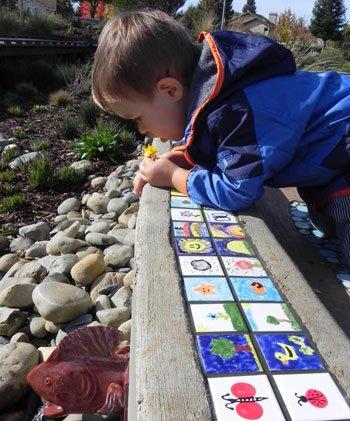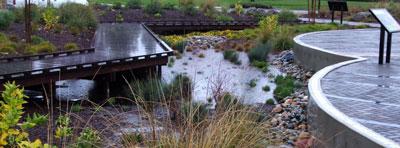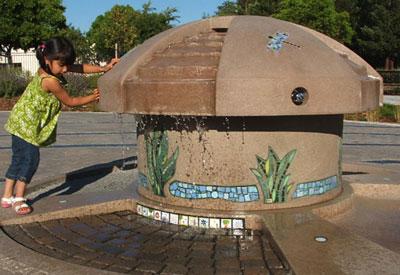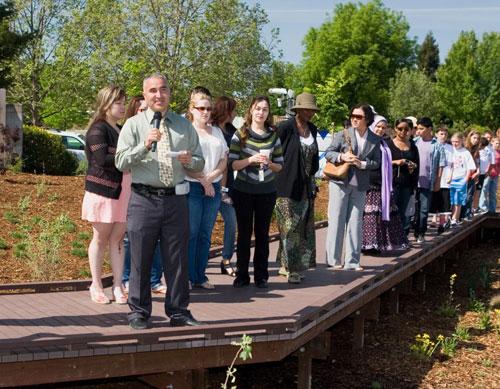Elk Grove Rain Garden Plaza Showcases Water Conservation
The City of Elk Grove won the 2013 Helen Putnam Award for Excellence in the Planning and Environmental Quality category. For more about the award program, visit www.helenputnam.org.
Home to nearly 160,000 residents in south Sacramento County, the City of Elk Grove has more than doubled in size since its incorporation in July 2000. Like many cities with growing populations, Elk Grove was increasingly concerned about preserving small urban open spaces, protecting water quality and promoting a healthy watershed.
Recognizing that stormwater is a resource rather than a nuisance, the city developed a public project to demonstrate sustainable stormwater management practices. The project’s overarching goal was to use a small open space to:
- Build community awareness about water conservation and watershed stewardship; and
- Highlight what individuals can do to reduce pollutants flowing into the local creeks.
The City of Elk Grove partnered with the Cosumnes Community Services District and an engineering firm to design and engineer a small lot adjacent to city hall with an educational emphasis on a sustainable approach to stormwater management.
Making Water Conservation Educational and Fun
The Rain Garden Plaza features a quarter-acre rain garden with a dry well to enhance groundwater recharge, a paved plaza area composed primarily of pervious pavers that allow water to pass through, and a shaded picnic area that serves as a quiet community gathering place.
The site uses California native drought-resistant plants to encourage sustainable landscaping, attract butterflies, birds and bees and promote water conservation. Fitness equipment is stationed on synthetic lawn that allows water to permeate the soil below. Fact-filled, colorful interpretive signs illustrate and provide information on various stormwater management techniques. An interactive sculpture, decorated with tiles painted by local schoolchildren, showcases different types of pervious and impervious surfaces.
The Rain Garden Plaza demonstrates several ways that stormwater moves through natural terrain. The low-impact development features slow the flow of stormwater and allow it to be absorbed by native plants before making its way toward the lowest point of the site, the rain garden. This design mimics the natural processes that occur in undeveloped watersheds and serves as a model of how residential and commercial development projects can be designed to conserve water.
“The plaza was built to educate the public by showcasing various innovative stormwater management techniques and sustainable landscaping practices used to promote water conservation and groundwater recharge, create wildlife habitat, improve water quality and protect downstream aquatic resources,” says Darren Wilson, engineering services manager for Elk Grove. “By applying these techniques and practices at their own residences and businesses, people can contribute through reducing their carbon footprint.”
The plaza’s design replaces typical roof downspouts with decorative water-harvesting rain chains that hang from the shade structure’s roof. The rain chains capture runoff and convey it to a rain barrel to hold water for future irrigation.
During its first rainy season in late 2012 and early 2013, the Rain Garden Plaza retained all water on-site from storms with one inch or less of rainfall during a 24-hour period. And 100 percent of the site runoff is treated in the stormwater quality features, avoiding costly underground mechanical devices.
Building a Sense of Community Ownership
The community has embraced the Rain Garden Plaza, and the public was involved with the development of the project from its inception, including the overall organic design and public art displays. More than 1,000 local elementary-school students from 32 classes and 14 schools hand-painted tiles to help accent the plaza with a message about water quality and aquatic resource protection. Volunteers planted much of the landscaping as part of a community volunteer day, which helped to create a sense of community ownership.
Throughout the year visitors can be seen watching the hummingbirds and butterflies that frequent the garden and its numerous native flowering plants. Employees from nearby businesses often use the fitness equipment and eat lunch under the shade structure. Residents, students and community groups are regularly seen walking the boardwalk, enjoying the interactive art sculpture, viewing the water-harvesting technologies on display and discovering new facts about stormwater pollution prevention from the colorful interpretive signs and educational tours.
Rain Garden Plaza Provides A Model for Sustainability
“The Rain Garden Plaza offers a superb example of an educational plaza that showcases sustainable stormwater management practices that protect the environment, especially our sensitive aquatic ecosystem,” says Barbara Washburn, ecotoxicology program lead at the Office of Environmental Health Hazard Assessment, California Environmental Protection Agency.
The plaza has become a destination for many stormwater professionals and a site for educational tours. It serves as a model — for the community, state agencies and other local municipalities — of low-impact development techniques and sustainable stormwater practices that promote healthy watersheds.
“The Rain Garden Plaza is truly a marriage of conservation and education,” says Mayor Gary Davis of Elk Grove. “It demonstrates that low-impact development practices can create a place of beauty and relaxation and that habitat can coexist with nature-driven stormwater management.”
Contact: Darren Wilson, engineering services manager, City of Elk Grove; phone: (916) 627-3446; email: dwilson@elkgrovecity.org.
This article appears in the July 2014 issue of Western City
Did you like what you read here? Subscribe
to Western City




